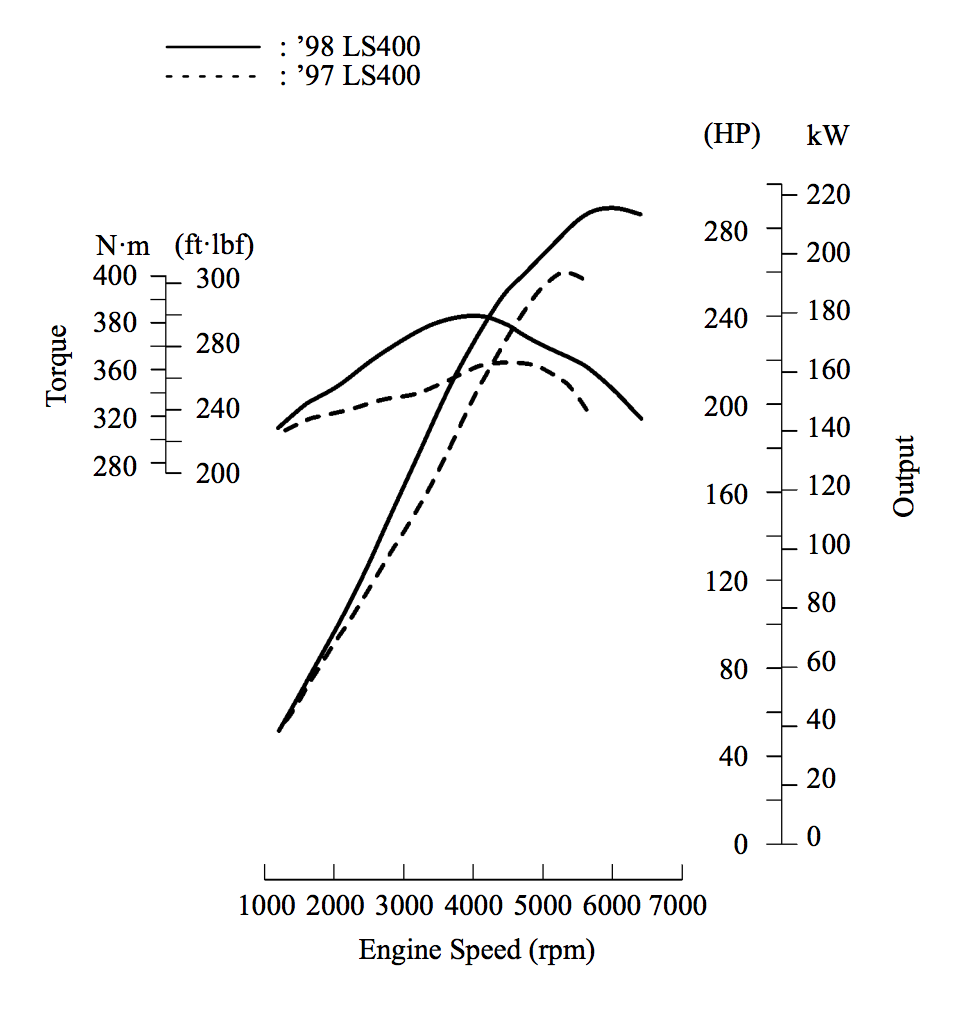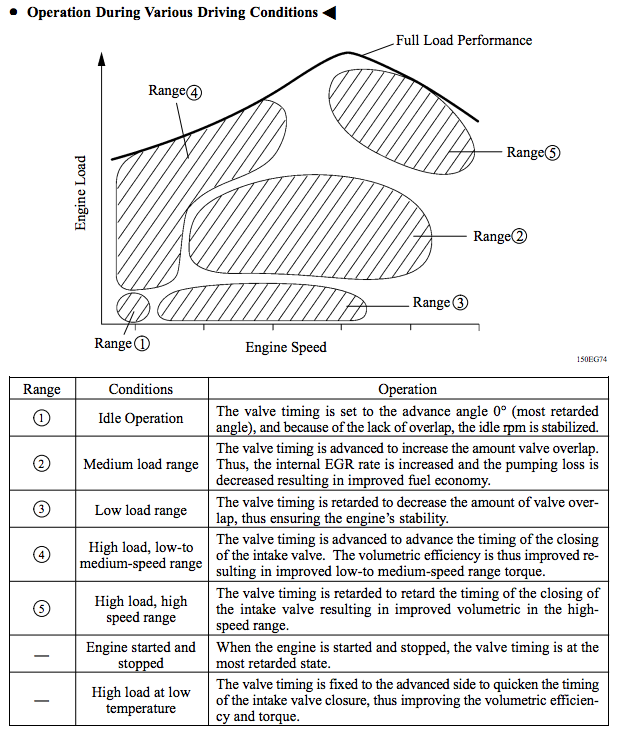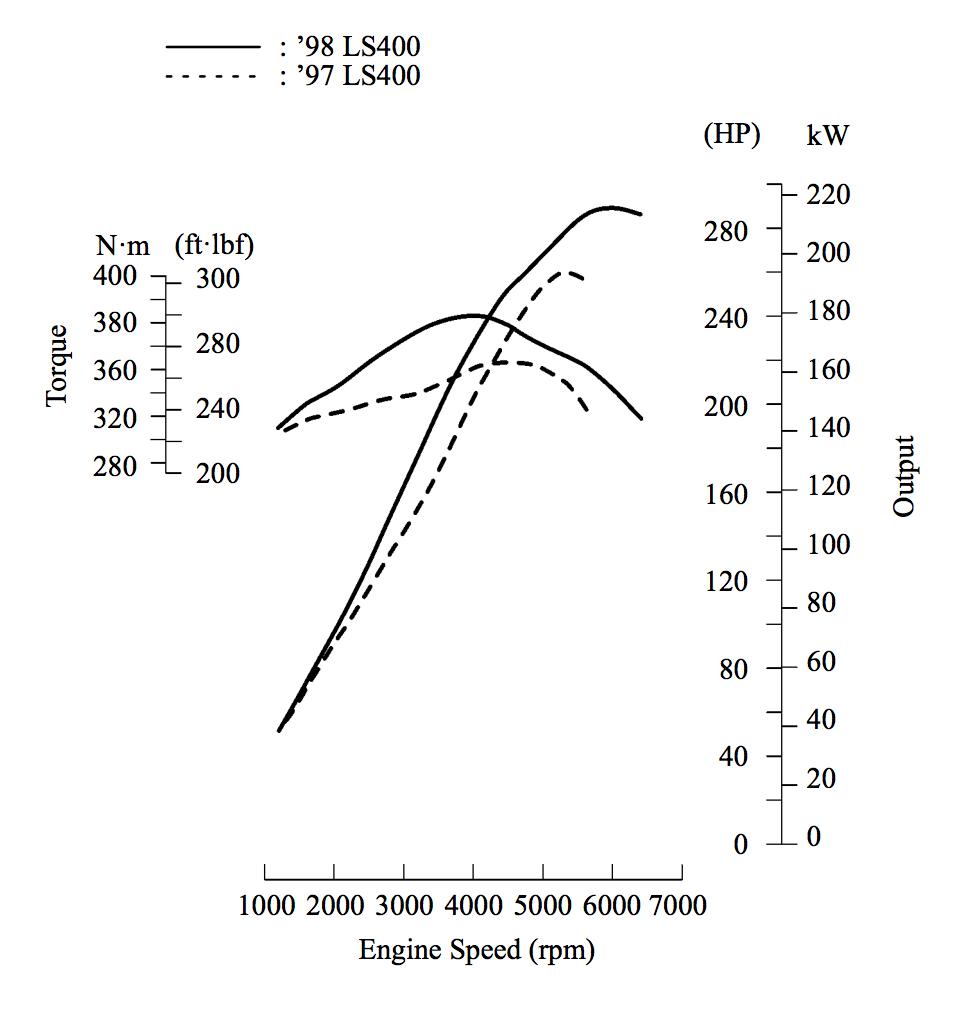VVT-i Question
#1
Driver
Thread Starter
Join Date: Oct 2013
Location: CA
Posts: 139
Likes: 0
Received 0 Likes
on
0 Posts
Well here's the catch - As I understand it VVT-i changes the valve timing to leave the intake valves open longer to ultimately increase power. Although, from what I have read, it only kicks in at 4-4.5k rpm. I don't understand how this is really an effective technology for the majority of users because I surely don't utilize that part of the rpm range often. Am I missing something here? Do most of you 98-00 guys feel that you're better off with the VVT-i? That being said, I'm not exactly in a position to race my car around as I have 220k+ on the clock and if all goes to plan I sure hope to make it last as long as possible.
On a recent vacation road trip I hit 5k rpm passing a super slow-poke and the car sure felt zippy: that was with the '00 LS with 140k and it really handled it well especially with a full load in the car. Hopefully me doing that with a full car isn't the end of the world.
Anyway, what do y'all have to say?
Matthew
On a recent vacation road trip I hit 5k rpm passing a super slow-poke and the car sure felt zippy: that was with the '00 LS with 140k and it really handled it well especially with a full load in the car. Hopefully me doing that with a full car isn't the end of the world.
Anyway, what do y'all have to say?
Matthew
#2
What is your actual Question?
VVTi doesn't work like VTEC in that it doesn't simply turn on at a specific RPM, it is oil pressure based so the timing change is gradual.
The VVTi engines make MUCH more power and have better fuel economy than earlier models due in large part to the VVTi.
VVTi doesn't work like VTEC in that it doesn't simply turn on at a specific RPM, it is oil pressure based so the timing change is gradual.
The VVTi engines make MUCH more power and have better fuel economy than earlier models due in large part to the VVTi.
#3
Driver School Candidate
Join Date: Apr 2015
Location: Germany
Posts: 9
Likes: 0
Received 0 Likes
on
0 Posts
The VVT-I System also works at revs lower than 4K. It serves better filling of the cylinders especially in lower revs like below 2K while accelerating. Maybe you read about VVTL-I System, which is an enhancment of VVT-I. VVTL-I uses different cams per valve depending on the revs you give the engine.
The below link gives a good explanation, but it's in german.
http://www.toyota-forum.de/threads/f...-vvtl-i.74931/
The below link gives a good explanation, but it's in german.

http://www.toyota-forum.de/threads/f...-vvtl-i.74931/
#4
Lead Lap
http://www.mr2.com/files/mr2/techinf...y.pdf#page=107
here you go boss... IN ENGLISH lol
VVT-i works continuously throughout the powerband, it can vary the intake camshaft by a range of up to 50 degrees using an oil controlled piston that moves on a helical spline which facilitates continuous change. it's not like VTEC which suddenly provides a longer cam profile at high revs.
what the 98-00 DOES have which operates in an "on, off" mode is the ACIS which is a variable length intake manifold (ohohoo fancy). you can hear it happening if you have the jbrady intake, at like 4900 rpm or something a set of 8 butterfly valves at the center of the intake manifold will simultaneously open which gives a shorter intake path to improve high rpm power. normally they are shut which makes the air follow a longer path around the outside of the manifold which (allegedly) improves low end torque.
so to answer the question, absolutely... VVT-i makes a big difference. you should get to the high rpms more often haha, your "race-derived" all aluminum, 6-bolt main bearing engine is probably getting bored over there lol. it'll handle the high rpms no problem, just change that oil regularly with good oil
here you go boss... IN ENGLISH lol
VVT-i works continuously throughout the powerband, it can vary the intake camshaft by a range of up to 50 degrees using an oil controlled piston that moves on a helical spline which facilitates continuous change. it's not like VTEC which suddenly provides a longer cam profile at high revs.
what the 98-00 DOES have which operates in an "on, off" mode is the ACIS which is a variable length intake manifold (ohohoo fancy). you can hear it happening if you have the jbrady intake, at like 4900 rpm or something a set of 8 butterfly valves at the center of the intake manifold will simultaneously open which gives a shorter intake path to improve high rpm power. normally they are shut which makes the air follow a longer path around the outside of the manifold which (allegedly) improves low end torque.
so to answer the question, absolutely... VVT-i makes a big difference. you should get to the high rpms more often haha, your "race-derived" all aluminum, 6-bolt main bearing engine is probably getting bored over there lol. it'll handle the high rpms no problem, just change that oil regularly with good oil
#5
Lead Lap

differences in the powerband
#7
I don't know about the LS version but the particular one that I have worked on both Intake an Exhaust cams were changed. Yes oil pressure does the work but its the ECU that tells it what to do. In most all of the systems I'm familiar with they are in operation from idle speed all the way to what ever rpm you demand with the pedal under your right foot.
Trending Topics
#8
Do you have a source for this? It doesn't make sense in several ways, not least of which i've never seen a '95-97 dyno past ~210-220whp, which indicates ~235-245hp.
The oil pressure is solenoid controlled. Newer Lexus and Toyota vehicles use Dual-VVTi which controls intake and exhaust cams.
I don't know about the LS version but the particular one that I have worked on both Intake an Exhaust cams were changed. Yes oil pressure does the work but its the ECU that tells it what to do. In most all of the systems I'm familiar with they are in operation from idle speed all the way to what ever rpm you demand with the pedal under your right foot.
#9
Lead Lap
#12
VVT-i isn't there to enhance power. It's there as an emissions control measure. Intake and exhaust valve overlap at certain RPM helps it pass emissions regulation requirements.
The power increase over non-VVT-i isn't that great. Moreover, there were many other changes that contributed to the power bump between the engines (head flow, etc). By reducing emissions with the VVT-i, it allowed engineers to increase power output of the engine a bit.
So really, VVT-i is really irrelevant to those of us that live in areas with lax emissions regs/ testing. Stick with the cheaper non-VVT-i if you are lucky and live in one of these areas.

The power increase over non-VVT-i isn't that great. Moreover, there were many other changes that contributed to the power bump between the engines (head flow, etc). By reducing emissions with the VVT-i, it allowed engineers to increase power output of the engine a bit.
So really, VVT-i is really irrelevant to those of us that live in areas with lax emissions regs/ testing. Stick with the cheaper non-VVT-i if you are lucky and live in one of these areas.

#13
Lead Lap
VVT-i isn't there to enhance power. It's there as an emissions control measure. Intake and exhaust valve overlap at certain RPM helps it pass emissions regulation requirements.
The power increase over non-VVT-i isn't that great. Moreover, there were many other changes that contributed to the power bump between the engines (head flow, etc). By reducing emissions with the VVT-i, it allowed engineers to increase power output of the engine a bit.
So really, VVT-i is really irrelevant to those of us that live in areas with lax emissions regs/ testing. Stick with the cheaper non-VVT-i if you are lucky and live in one of these areas.

The power increase over non-VVT-i isn't that great. Moreover, there were many other changes that contributed to the power bump between the engines (head flow, etc). By reducing emissions with the VVT-i, it allowed engineers to increase power output of the engine a bit.
So really, VVT-i is really irrelevant to those of us that live in areas with lax emissions regs/ testing. Stick with the cheaper non-VVT-i if you are lucky and live in one of these areas.


#14
VVT-i isn't there to enhance power. It's there as an emissions control measure. Intake and exhaust valve overlap at certain RPM helps it pass emissions regulation requirements.
The power increase over non-VVT-i isn't that great. Moreover, there were many other changes that contributed to the power bump between the engines (head flow, etc). By reducing emissions with the VVT-i, it allowed engineers to increase power output of the engine a bit.
So really, VVT-i is really irrelevant to those of us that live in areas with lax emissions regs/ testing. Stick with the cheaper non-VVT-i if you are lucky and live in one of these areas.

The power increase over non-VVT-i isn't that great. Moreover, there were many other changes that contributed to the power bump between the engines (head flow, etc). By reducing emissions with the VVT-i, it allowed engineers to increase power output of the engine a bit.
So really, VVT-i is really irrelevant to those of us that live in areas with lax emissions regs/ testing. Stick with the cheaper non-VVT-i if you are lucky and live in one of these areas.

You are wrong. period.
Spend some time looking at the dyno charts of pre-VVTi 1UZ and VVTi 1UZ engines, the gains are MASSIVE. the VVTi heads flow SO MUCH BETTER than the early heads it's not even funny. A ported/polished/OS Valved 1st/1.5gen head flows below a stock VVTi head!
Post some substantiating information on your claims if you can.
#15
This is incorrect in just about every way.
You are wrong. period.
Spend some time looking at the dyno charts of pre-VVTi 1UZ and VVTi 1UZ engines, the gains are MASSIVE. the VVTi heads flow SO MUCH BETTER than the early heads it's not even funny. A ported/polished/OS Valved 1st/1.5gen head flows below a stock VVTi head!
Post some substantiating information on your claims if you can.
You are wrong. period.
Spend some time looking at the dyno charts of pre-VVTi 1UZ and VVTi 1UZ engines, the gains are MASSIVE. the VVTi heads flow SO MUCH BETTER than the early heads it's not even funny. A ported/polished/OS Valved 1st/1.5gen head flows below a stock VVTi head!
Post some substantiating information on your claims if you can.
The VVTi are engineered to make more power BECAUSE the VVTi does a good job controlling emissions. The power increase comes from things like you have already said - better flowing intake, etc. If the engines do not pass emissions, they aren't going allowed to go to market. It isn't the VVTi which CAUSES the power increase.
People have tuned non vvti engines to make just as much or more power than the later VVTi engines, by doing similar mods -- intake, porting and polishing to make the non-vvti flow as good as the redesigned vvti heads, etc. I'd rather not post links because I don't know your rules about that here (don't know about specific rivalries, what you consider "advertising" etc). But if people search for it, they can find 290 HP in NA non-vvti is easily obtainable. It probably won't pass CA or other emissions, but it's doable.
Also, take there is the fact that EGR was removed from the VVTi engines a couple of years after their intro, which speaks for itself. VVTi works well on controlling the emissions, so EGR was not needed.






